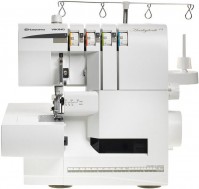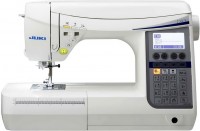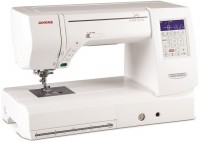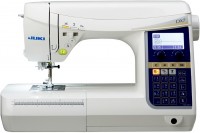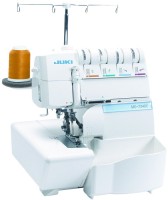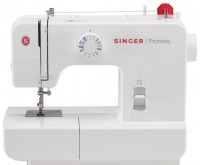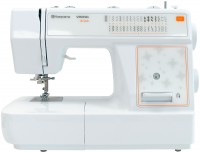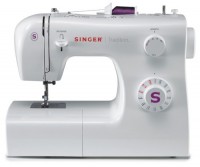Sewing Machines & Overlockers Brother embroidery
All models Advanced filters → |
You might be interested in
Sewing Machines & Overlockers: specifications, types
Type of sewing machine
The general type of sewing machine, which determines its functionality and specific application.
— Electromechanical. The classic, simplest type of sewing machines: they do not have computer control, all operating parameters are adjusted mechanically, and their use is limited to the simplest types of seams.
- Computerized. Sewing machines equipped with built-in computers that control the sewing process. Thanks to this, they have a more extensive set of functions and are more precise in setting than electromechanical ones, although they cost accordingly. Note that in this case we mean exclusively computerized sewing machines; embroidery and sewing-embroidery machines are divided into separate categories (see the corresponding paragraphs).
— Embroidery. Such machines were initially intended only for embroidering patterns, and are practically not suitable for work outside this specialization (regular sewing, hemming). They have appropriate design features, are equipped with a hoop and embroidery feet, and are often equipped with both a set of built-in presets (for example, embroidering letters of the alphabet) and the ability to connect to a PC and download patterns.
— Sewing and embroidery. Machines that can be used for both sewing and embroidery. The design and sewing capabilities are similar to computerized...models (see the corresponding paragraph), but are complemented by an embroidery unit, hoop and other embroidery equipment. And the built-in capabilities usually include both basic embroidery elements (crosses, stars, satin stitch, etc.) and the ability to embroider using patterns downloaded from a computer. Such machines are very versatile, but in terms of specific capabilities they may be inferior to more specialized models.
— Overlock. A special type of sewing machine designed primarily for seaming and trimming the edges of materials. An overlocker covers the edge of the fabric with a special seam, which prevents fraying, fraying and deformation. One of the design features of such devices is the presence of several working threads, from 2 to 10 (most often 3 or 4).
— Coverstitching machine. Devices designed to create the so-called. cover stitch - a flat elastic seam that is most often used to hem the folded edge in knitwear, as well as in some types of joints. Such machines are not used for other purposes.
— Coverlock. Devices that combine an overlocker and a cover stitching machine in one housing. For more information about each of these varieties, see the corresponding paragraph. Here we note that a carpet lock is actually a universal tool for processing edges: it is capable of overcasting them, cutting off excess fabric and hemming the folded edge with a cover stitch. In addition, many modern carpet stitchers are also capable of stitching materials (mainly with a two-thread chain stitch).
— Electromechanical. The classic, simplest type of sewing machines: they do not have computer control, all operating parameters are adjusted mechanically, and their use is limited to the simplest types of seams.
- Computerized. Sewing machines equipped with built-in computers that control the sewing process. Thanks to this, they have a more extensive set of functions and are more precise in setting than electromechanical ones, although they cost accordingly. Note that in this case we mean exclusively computerized sewing machines; embroidery and sewing-embroidery machines are divided into separate categories (see the corresponding paragraphs).
— Embroidery. Such machines were initially intended only for embroidering patterns, and are practically not suitable for work outside this specialization (regular sewing, hemming). They have appropriate design features, are equipped with a hoop and embroidery feet, and are often equipped with both a set of built-in presets (for example, embroidering letters of the alphabet) and the ability to connect to a PC and download patterns.
— Sewing and embroidery. Machines that can be used for both sewing and embroidery. The design and sewing capabilities are similar to computerized...models (see the corresponding paragraph), but are complemented by an embroidery unit, hoop and other embroidery equipment. And the built-in capabilities usually include both basic embroidery elements (crosses, stars, satin stitch, etc.) and the ability to embroider using patterns downloaded from a computer. Such machines are very versatile, but in terms of specific capabilities they may be inferior to more specialized models.
— Overlock. A special type of sewing machine designed primarily for seaming and trimming the edges of materials. An overlocker covers the edge of the fabric with a special seam, which prevents fraying, fraying and deformation. One of the design features of such devices is the presence of several working threads, from 2 to 10 (most often 3 or 4).
— Coverstitching machine. Devices designed to create the so-called. cover stitch - a flat elastic seam that is most often used to hem the folded edge in knitwear, as well as in some types of joints. Such machines are not used for other purposes.
— Coverlock. Devices that combine an overlocker and a cover stitching machine in one housing. For more information about each of these varieties, see the corresponding paragraph. Here we note that a carpet lock is actually a universal tool for processing edges: it is capable of overcasting them, cutting off excess fabric and hemming the folded edge with a cover stitch. In addition, many modern carpet stitchers are also capable of stitching materials (mainly with a two-thread chain stitch).
Shuttle
The type of shuttle provided in the design of the sewing machine.
The shuttle is a device for feeding the lower thread; This is where the bobbin and thread is inserted. The following types of shuttles are found in modern machines:
- Rocking. Swinging shuttles have only a vertical layout. This is a simple, inexpensive and at the same time reliable mechanism, which also makes the device almost “omnivorous”: many models with swinging shuttles are able to cope with thick, coarse fabrics that are “too tough” for other types of machines. In addition, in such a shuttle it is very easy to adjust the method of thread tension. Among the disadvantages of this option, it is worth noting the increased level of vibration and noise, relatively low speed, as well as a more complex threading procedure than in horizontal shuttles.
— Vertical rotational. In a number of features, such shuttles are similar to swinging shuttles (see the corresponding paragraph): in particular, they are relatively simple to adjust the thread tension, but to thread the bobbin you must every time reach into the mechanism and remove the bobbin case from the shuttle. The key difference is that the shuttle does not swing during operation, but rotates. Because of this, such mechanisms are somewhat more complex and more expensive than swinging ones, but they provide higher sewing speeds with lower levels of vibration and noise....This option is used in professional and semi-professional machines, as well as industrial equipment.
— Horizontal rotational. Shuttles of this type are easy to use: to thread the bobbin thread, you do not need to remove the bobbin case; just open the cover and install the bobbin directly into the shuttle. In addition, the top cover is often made transparent, which allows you to monitor the remainder of the lower thread. Moreover, due to the rotational principle of operation, such a shuttle provides good speed and a minimum level of vibration and noise. Among the disadvantages of this option, one can note the difficulty in adjusting the thread tension: to do this, as a rule, you have to unscrew several bolts and remove the entire shuttle (whereas in vertical mechanisms the regulator is located on a quickly removable bobbin head). In addition, horizontal shuttles are not suitable for constant sewing with coarse threads - such a thread can rub a groove in the body, after which the mechanism will have to be changed.
The shuttle is a device for feeding the lower thread; This is where the bobbin and thread is inserted. The following types of shuttles are found in modern machines:
- Rocking. Swinging shuttles have only a vertical layout. This is a simple, inexpensive and at the same time reliable mechanism, which also makes the device almost “omnivorous”: many models with swinging shuttles are able to cope with thick, coarse fabrics that are “too tough” for other types of machines. In addition, in such a shuttle it is very easy to adjust the method of thread tension. Among the disadvantages of this option, it is worth noting the increased level of vibration and noise, relatively low speed, as well as a more complex threading procedure than in horizontal shuttles.
— Vertical rotational. In a number of features, such shuttles are similar to swinging shuttles (see the corresponding paragraph): in particular, they are relatively simple to adjust the thread tension, but to thread the bobbin you must every time reach into the mechanism and remove the bobbin case from the shuttle. The key difference is that the shuttle does not swing during operation, but rotates. Because of this, such mechanisms are somewhat more complex and more expensive than swinging ones, but they provide higher sewing speeds with lower levels of vibration and noise....This option is used in professional and semi-professional machines, as well as industrial equipment.
— Horizontal rotational. Shuttles of this type are easy to use: to thread the bobbin thread, you do not need to remove the bobbin case; just open the cover and install the bobbin directly into the shuttle. In addition, the top cover is often made transparent, which allows you to monitor the remainder of the lower thread. Moreover, due to the rotational principle of operation, such a shuttle provides good speed and a minimum level of vibration and noise. Among the disadvantages of this option, one can note the difficulty in adjusting the thread tension: to do this, as a rule, you have to unscrew several bolts and remove the entire shuttle (whereas in vertical mechanisms the regulator is located on a quickly removable bobbin head). In addition, horizontal shuttles are not suitable for constant sewing with coarse threads - such a thread can rub a groove in the body, after which the mechanism will have to be changed.
Loop formation
A method of forming slotted loops supported by a machine.
— Automatic. Fully automatic buttonhole sewing mode; the user only needs to set the length, after which the machine will independently process the edges of the future loop, without the need to switch modes manually. The most convenient and advanced option; It is the automatic method that is recommended if you plan to sew a large number of loops.
— Semi-automatic. When forming a loop in this way, the work is done in 2 or 4 steps. For example, in the first case, the machine makes one short bartack and one long longitudinal stitch in one pass, then the mode switches and a second bartack and a second long stitch are performed; in the second case, accordingly, you have to switch between 4 stages. Such work takes more time than automatic loop formation, but such machines are cheaper.
— Automatic. Fully automatic buttonhole sewing mode; the user only needs to set the length, after which the machine will independently process the edges of the future loop, without the need to switch modes manually. The most convenient and advanced option; It is the automatic method that is recommended if you plan to sew a large number of loops.
— Semi-automatic. When forming a loop in this way, the work is done in 2 or 4 steps. For example, in the first case, the machine makes one short bartack and one long longitudinal stitch in one pass, then the mode switches and a second bartack and a second long stitch are performed; in the second case, accordingly, you have to switch between 4 stages. Such work takes more time than automatic loop formation, but such machines are cheaper.
Number of stitches
The number of stitches that a sewing machine can sew. The larger this number, the more extensive the capabilities of this model, the wider the choice the user has; however, it wouldn’t hurt to clarify the specific range of supported stitches separately.
The fewest options - mostly up to 25 - are provided in electromechanical machines, as well as specialized devices such as overlockers and carpet lockers (see “Type”). In computer-controlled devices, the number of lines can be in the dozens, and some also allow you to download additional options from the computer.
The fewest options - mostly up to 25 - are provided in electromechanical machines, as well as specialized devices such as overlockers and carpet lockers (see “Type”). In computer-controlled devices, the number of lines can be in the dozens, and some also allow you to download additional options from the computer.
Number of loops
The number of welt stitches that a sewing machine can make. Different types of loops are used for different types of fabrics and clothing. The larger this number, the wider the choice the user has and the less likely it is that the machine’s arsenal will not have the required type of loop.
Max. stitch length
The maximum stitch length that the sewing machine can sew. This parameter is important for working with dense thick fabrics: the stronger the fabric, the longer the seam used for it. Accordingly, the longer the stitch ( 5 mm or more), the better the machine is suitable for working with similar fabrics.
Max. stitch width
The maximum stitch width provided by a sewing machine.
Most modern sewing machines are capable of working not only with the simplest longitudinal seam (when punctures with a needle occur strictly one after another), but also with seams that cover a certain width - for example, zigzag and various decorative ones. And in overlockers, such opportunities are generally available by definition.
The larger the maximum stitch width, the correspondingly wider the machine’s ability to work with specific types of seams (all other things being equal). An indicator of up to 5 mm is typical mainly for entry-level devices, 5 - 7 mm - average, 7 mm and more - advanced.
Most modern sewing machines are capable of working not only with the simplest longitudinal seam (when punctures with a needle occur strictly one after another), but also with seams that cover a certain width - for example, zigzag and various decorative ones. And in overlockers, such opportunities are generally available by definition.
The larger the maximum stitch width, the correspondingly wider the machine’s ability to work with specific types of seams (all other things being equal). An indicator of up to 5 mm is typical mainly for entry-level devices, 5 - 7 mm - average, 7 mm and more - advanced.
Max. presser foot height
Distance from the working surface to the foot in the uppermost position. Must be taken into account when working with thick fabrics.
Sewing speed
The maximum sewing speed provided by the sewing machine. In the vast majority of models, this parameter can be adjusted, so if necessary, you can sew at a lower speed.
The more stitches a machine makes per minute, the higher its productivity, the better suited it is for large volumes of work. At the same time, it is worth considering that high speed has a corresponding impact on price and energy consumption, and it is not always required. Detailed recommendations on choosing the optimal speed for certain types of work can be found in special sources.
The more stitches a machine makes per minute, the higher its productivity, the better suited it is for large volumes of work. At the same time, it is worth considering that high speed has a corresponding impact on price and energy consumption, and it is not always required. Detailed recommendations on choosing the optimal speed for certain types of work can be found in special sources.
Features
— Embroidering the letters of the alphabet. The ability to embroider letters of the alphabet using a typewriter. This function is found in computer-controlled models, it is carried out due to a set of letters entered in the memory of the machine. Many models with this feature have several built-in fonts, and some even allow you to upload your own fonts from your computer.
— Differential conveyor. The fabric conveyor, consisting of two gear racks — in front of and behind the needle. Depending on the set mode, such a conveyor can additionally stretch or, conversely, collect fabric during sewing; the first is useful when working with dense fabrics, the second — for knitwear, stretch and other easily stretching materials.
— Reverse. A function that allows you to switch the direction of movement of the fabric under the needle and, accordingly, the direction of the seam. Mainly used for stitching. Reverse is practically obligatory for sewing machines in the classical sense of the word — electromechanical, computerized and sewing-embroidery (see "Type"), but practically does not occur in other types.
— Sleeve platform. A device for working with sleeves, trousers and other similar parts of clothing. This function is most often implemented due to the removable part of the desktop — when it is removed, the table turns into a narrow platform. The specific widt...h of such a device may be different, it should be specified separately.
— Needle threader. A special device designed to facilitate the process of threading a needle. The presence of a needle threader is especially useful when changing threads frequently (for example, sewing alternately with different colours).
— Thread cutter. Mechanism for cutting the threads after sewing, eliminating the need to use scissors: to cut the thread, just press the button. Note that we are talking about an automatic thread cutter; hand tools mounted on the bodies of some machines are not considered thread cutters in this case.
— Sewing without a pedal. The ability to use the machine without connecting the pedal. To start and stop the process in such models, usually, a special button is provided. Such an opportunity can be useful for long sewing, when it would be tiring to keep the pedal constantly depressed, and for occasional use, when the machine starts “for a couple of stitches” and there is no need to fiddle with connecting the pedal.
— Sewing with a double needle. The possibility of using a machine for sewing with a double needle — a pair of needles fixed in one holder. There are different types of such needles and different methods of working with them, and some work is done only with a double needle. Anyway, the use of such devices requires that the machine be initially compatible with them.
— Positioning of the needle (top / bottom). A switch that allows the user to select whether the needle will be in the up or down position after the motor stops. In the absence of such a switch, the needle, usually, stops only in the upper position, and this is not always convenient
— Differential conveyor. The fabric conveyor, consisting of two gear racks — in front of and behind the needle. Depending on the set mode, such a conveyor can additionally stretch or, conversely, collect fabric during sewing; the first is useful when working with dense fabrics, the second — for knitwear, stretch and other easily stretching materials.
— Reverse. A function that allows you to switch the direction of movement of the fabric under the needle and, accordingly, the direction of the seam. Mainly used for stitching. Reverse is practically obligatory for sewing machines in the classical sense of the word — electromechanical, computerized and sewing-embroidery (see "Type"), but practically does not occur in other types.
— Sleeve platform. A device for working with sleeves, trousers and other similar parts of clothing. This function is most often implemented due to the removable part of the desktop — when it is removed, the table turns into a narrow platform. The specific widt...h of such a device may be different, it should be specified separately.
— Needle threader. A special device designed to facilitate the process of threading a needle. The presence of a needle threader is especially useful when changing threads frequently (for example, sewing alternately with different colours).
— Thread cutter. Mechanism for cutting the threads after sewing, eliminating the need to use scissors: to cut the thread, just press the button. Note that we are talking about an automatic thread cutter; hand tools mounted on the bodies of some machines are not considered thread cutters in this case.
— Sewing without a pedal. The ability to use the machine without connecting the pedal. To start and stop the process in such models, usually, a special button is provided. Such an opportunity can be useful for long sewing, when it would be tiring to keep the pedal constantly depressed, and for occasional use, when the machine starts “for a couple of stitches” and there is no need to fiddle with connecting the pedal.
— Sewing with a double needle. The possibility of using a machine for sewing with a double needle — a pair of needles fixed in one holder. There are different types of such needles and different methods of working with them, and some work is done only with a double needle. Anyway, the use of such devices requires that the machine be initially compatible with them.
— Positioning of the needle (top / bottom). A switch that allows the user to select whether the needle will be in the up or down position after the motor stops. In the absence of such a switch, the needle, usually, stops only in the upper position, and this is not always convenient
Adjustments
— Presser foot pressure adjustment. The ability to change the degree of pressure of the foot on the fabric, adjusting it to the thickness of the material: for thin fabrics (chiffon, knitwear), the pressure should be small, for thick ones — on the contrary.
— Thread tension regulator. A device that allows you to adjust the degree of tension of the upper thread. A mismatch in tension between the top and bottom threads causes one of the threads to pull the other and the seam deteriorates; To avoid this phenomenon, this function is provided. Note that tension adjustment is also possible for the lower thread — it is carried out through the shuttle (all shuttles have this option). But for this it is necessary to remove the bobbin case, or even the entire shuttle. The top regulator is located directly on the body of the machine, and it is much easier to use it.
— Puncture force stabilizer. A device that provides a stable puncture force regardless of the engine speed. A feature of the mechanics of electric motors is that without special adjustment, the puncture force decreases markedly with an increase in speed. This function allows you to maintain approximately the same level over the entire speed range, which has a positive effect on the quality of work.
— Shutdown of the lower conveyor. Possibility to turn off the lower c...onveyor of the machine. This feature is indispensable for work in which the fabric needs to be shifted manually — for example, embroidering along a complex contour on a typewriter without an embroidery unit, sewing on buttons, etc.
— Speed limiter. The ability to set a speed limit for the machine. Thanks to this function, you can not be afraid to "squeeze" the pedal — even with strong pressure, the machine will work at a given speed, and no faster. This feature is useful, in particular, in jobs where you need to carefully control the process.
— Knee lever for lifting the foot. A device that allows you to raise the presser foot and lower the lower feed dog with a knee movement without removing your hands from the fabric. Such a device is useful for quilting and some types of embroidery.
— Thread tension regulator. A device that allows you to adjust the degree of tension of the upper thread. A mismatch in tension between the top and bottom threads causes one of the threads to pull the other and the seam deteriorates; To avoid this phenomenon, this function is provided. Note that tension adjustment is also possible for the lower thread — it is carried out through the shuttle (all shuttles have this option). But for this it is necessary to remove the bobbin case, or even the entire shuttle. The top regulator is located directly on the body of the machine, and it is much easier to use it.
— Puncture force stabilizer. A device that provides a stable puncture force regardless of the engine speed. A feature of the mechanics of electric motors is that without special adjustment, the puncture force decreases markedly with an increase in speed. This function allows you to maintain approximately the same level over the entire speed range, which has a positive effect on the quality of work.
— Shutdown of the lower conveyor. Possibility to turn off the lower c...onveyor of the machine. This feature is indispensable for work in which the fabric needs to be shifted manually — for example, embroidering along a complex contour on a typewriter without an embroidery unit, sewing on buttons, etc.
— Speed limiter. The ability to set a speed limit for the machine. Thanks to this function, you can not be afraid to "squeeze" the pedal — even with strong pressure, the machine will work at a given speed, and no faster. This feature is useful, in particular, in jobs where you need to carefully control the process.
— Knee lever for lifting the foot. A device that allows you to raise the presser foot and lower the lower feed dog with a knee movement without removing your hands from the fabric. Such a device is useful for quilting and some types of embroidery.
Embroidery unit
The presence of an embroidery unit in the machine — an additional device in the form of a platform with a hoop that can move under the needle in different directions. In accordance with the name, such a block allows you to automatically embroider various patterns and patterns.
Max. embroidery area
The maximum size of the area that the machine in embroidering mode can process at one time, without re-stretching the fabric on the hoop. In other words, this is the maximum size of the pattern that the device can embroider "in one go."
The meaning of this parameter is obvious: it allows you to evaluate whether the selected model is suitable for embroidering patterns of the planned size.
The meaning of this parameter is obvious: it allows you to evaluate whether the selected model is suitable for embroidering patterns of the planned size.
Number of embroidery patterns
The number of embroidery patterns supported by the machine.
In this case, usually, it means the number of drawings that can be simultaneously written to the device's memory and stored there. The more diverse the planned embroidery work, the more memory is desirable for them. However, in modern models, the number of drawings often reaches several dozen.
In this case, usually, it means the number of drawings that can be simultaneously written to the device's memory and stored there. The more diverse the planned embroidery work, the more memory is desirable for them. However, in modern models, the number of drawings often reaches several dozen.
Number of hoops
The number of hoops supplied with the machine.
The presence of several hoops in the kit allows you to minimize interruptions in work: while the machine is embroidering on some hoops, you can fasten the next workpiece to others, and after embroidering, you can quickly replace the hoops.
The presence of several hoops in the kit allows you to minimize interruptions in work: while the machine is embroidering on some hoops, you can fasten the next workpiece to others, and after embroidering, you can quickly replace the hoops.
Presser foots
Types of feet supplied with the sewing machine.
— Universal. A foot used for standard sewing, mainly straight stitches and zigzags.
— Overlock foot. A foot designed for overlocking. By definition, it is found in devices with an overlock function (see “Type”), however, it can also be provided in traditional sewing machines. In the latter case, such a foot, of course, will not replace a full-fledged overlock, but in some situations it allows you to do without it.
— Upper fabric conveyor. An additional top-mounted feed dog in place of the stock foot, in addition to the standard bottom feed dog. Such a device makes it easier to work with thin, delicate and sliding fabrics, as well as sewing together several layers of fabric: the material moves as evenly as possible, without distortions and displacements.
— Foot for sewing in a zipper. The foot for sewing in a zipper can have a different size and design — in particular, there are special devices for sewing in a hidden zipper. The specific features of this device should be clarified separately.
— Foot for decorative stitching. Feet designed for various types of decorative stitching. Such a line may not have a functional role, its main task is to emphasize a certain element of clothing (edges, pockets, individual seams, etc.). Anyway, the stitch line sh...ould usually strictly follow the contour along which it is applied — and this contour can consist of both straight lines and curved lines. Special foots for decorative stitching simplify the task: they are equipped with rulers or other devices that allow you to control the parallelism of the stitches.
— Satin stitch foot. This foot will be suitable for appliqué and other work where zigzag stitches are often used.
— Blind stitch foot. Foot designed for blind seams used when hemming the edge of the fabric. It is equipped with a device that provides a hem of the fabric and in this position feeds it under the needle.
— Quilting foot. Special feet for quilting — patchwork. In such works, it is necessary to sew the fabric in several layers, as well as to perform figured seams. In extreme cases, you can use the usual universal foot for quilting, but using a special device is still much more convenient.
— Monogramming foot. The foot for embroidery of monograms will allow you to make embroidery on any object, thereby "decorating" it with your signature or the emblem of any institution, company, sports club.
— Buttonhole foot. Buttonhole foot. It eliminates the need for manual work. The sewing machine will do everything for you, which will reduce your time and please you with quality.
— Foot for sewing on buttons. A foot designed to hold the button on the fabric while sewing on. It has a special protrusion pointing down: when the main part of the foot is pressed against the button, this protrusion presses the fabric and prevents it from slipping.
In addition to the above, other types of feet may be included in the delivery package — for example, for satin stitching, for processing sections, etc.
— Universal. A foot used for standard sewing, mainly straight stitches and zigzags.
— Overlock foot. A foot designed for overlocking. By definition, it is found in devices with an overlock function (see “Type”), however, it can also be provided in traditional sewing machines. In the latter case, such a foot, of course, will not replace a full-fledged overlock, but in some situations it allows you to do without it.
— Upper fabric conveyor. An additional top-mounted feed dog in place of the stock foot, in addition to the standard bottom feed dog. Such a device makes it easier to work with thin, delicate and sliding fabrics, as well as sewing together several layers of fabric: the material moves as evenly as possible, without distortions and displacements.
— Foot for sewing in a zipper. The foot for sewing in a zipper can have a different size and design — in particular, there are special devices for sewing in a hidden zipper. The specific features of this device should be clarified separately.
— Foot for decorative stitching. Feet designed for various types of decorative stitching. Such a line may not have a functional role, its main task is to emphasize a certain element of clothing (edges, pockets, individual seams, etc.). Anyway, the stitch line sh...ould usually strictly follow the contour along which it is applied — and this contour can consist of both straight lines and curved lines. Special foots for decorative stitching simplify the task: they are equipped with rulers or other devices that allow you to control the parallelism of the stitches.
— Satin stitch foot. This foot will be suitable for appliqué and other work where zigzag stitches are often used.
— Blind stitch foot. Foot designed for blind seams used when hemming the edge of the fabric. It is equipped with a device that provides a hem of the fabric and in this position feeds it under the needle.
— Quilting foot. Special feet for quilting — patchwork. In such works, it is necessary to sew the fabric in several layers, as well as to perform figured seams. In extreme cases, you can use the usual universal foot for quilting, but using a special device is still much more convenient.
— Monogramming foot. The foot for embroidery of monograms will allow you to make embroidery on any object, thereby "decorating" it with your signature or the emblem of any institution, company, sports club.
— Buttonhole foot. Buttonhole foot. It eliminates the need for manual work. The sewing machine will do everything for you, which will reduce your time and please you with quality.
— Foot for sewing on buttons. A foot designed to hold the button on the fabric while sewing on. It has a special protrusion pointing down: when the main part of the foot is pressed against the button, this protrusion presses the fabric and prevents it from slipping.
In addition to the above, other types of feet may be included in the delivery package — for example, for satin stitching, for processing sections, etc.
Display
The sewing machine has its own display. It can be either the simplest segment screen capable of displaying 2-3 characters, or a matrix of pixels, which can display not only inscriptions, but also graphic information — pictures, diagrams, progress indicators, etc. Anyway, this function makes working with the machine more convenient and visual: even the simplest screen provides a lot of additional information. And large displays can even be made touch-sensitive and used to control the device.
Led lighting
Built-in lighting system that illuminates the working table of the machine, which is made on LEDs. In addition to bright illumination of the work area, LED-backlit sewing machines also have lower energy consumption compared to classic lamps.
Custom stitches
Possibility to create your own stitch types and store them in the sewing machine memory. The specific method of creation may be different: in some models, for this you need to use a computer and load the ready-made settings into the machine, others allow you to do everything on the machine itself, without additional equipment. Anyway, this function gives the user additional creative freedom; it is especially useful for those who plan to often use a non-standard line.
PC connection
How to connect a sewing machine to a computer. By itself, such a connection can be used, in particular, to download new patterns or stitches, update the firmware and control the machine from a PC directly. And the connection methods can be as follows:
— USB. Wired connection to a standard USB port. For this purpose, the appropriate cable is provided in the kit. A fairly convenient and versatile option: almost all modern PCs and laptops have USB ports, and such a connection can be used both for file exchange and for direct control of the machine. However, the cable usually has a relatively short length (usually up to 1.5 m), which can create difficulties: it is not always possible to install a sewing machine and a computer at a distance sufficient for connection.
— Card reader. Memory card reader — usually SD/MMC; specific supported SD card standards should be specified separately. In this case, we are not talking about a direct connection but about data exchange: the necessary files (for example, patterns for embroidery) are written from a PC or laptop to the memory card, after which it is inserted into the machine.
— USB / card reader. Ability to work with both of the above connection options. It allows the user to choose the method that is most convenient in the current situation at his discretion.
— Wireless. Connect wirelessly, usually via Bluetooth. The main convenience of such a connection...is the absence of wires, while it works confidently at least at a distance of several metres (within the same room). On the other hand, wireless capabilities affect the cost of the machine, and an additional adapter may be required to connect via Bluetooth to a desktop PC.
— USB. Wired connection to a standard USB port. For this purpose, the appropriate cable is provided in the kit. A fairly convenient and versatile option: almost all modern PCs and laptops have USB ports, and such a connection can be used both for file exchange and for direct control of the machine. However, the cable usually has a relatively short length (usually up to 1.5 m), which can create difficulties: it is not always possible to install a sewing machine and a computer at a distance sufficient for connection.
— Card reader. Memory card reader — usually SD/MMC; specific supported SD card standards should be specified separately. In this case, we are not talking about a direct connection but about data exchange: the necessary files (for example, patterns for embroidery) are written from a PC or laptop to the memory card, after which it is inserted into the machine.
— USB / card reader. Ability to work with both of the above connection options. It allows the user to choose the method that is most convenient in the current situation at his discretion.
— Wireless. Connect wirelessly, usually via Bluetooth. The main convenience of such a connection...is the absence of wires, while it works confidently at least at a distance of several metres (within the same room). On the other hand, wireless capabilities affect the cost of the machine, and an additional adapter may be required to connect via Bluetooth to a desktop PC.
Power source
The lion's share of electronic sewing machines, overlockers and other similar devices is mains powered. However, there are also mobile options, in which, in addition to mains power, autonomous power from a battery or batteries is also provided.
Power consumption
The power consumed by the machine during operation. Usually, the maximum power value is indicated in the characteristics.
Most of the electricity supplied to the machine is consumed by the engine, so this indicator primarily describes the power of the engine. The higher this power, the faster the machine can work and the better it is suitable for working with dense fabrics. However, there is no strict dependence here, much also depends on the general specialization of the unit.
Most of the electricity supplied to the machine is consumed by the engine, so this indicator primarily describes the power of the engine. The higher this power, the faster the machine can work and the better it is suitable for working with dense fabrics. However, there is no strict dependence here, much also depends on the general specialization of the unit.
Sewing advisor
Built-in help system that displays various tips on the display. Some sewing advisers are capable of providing very detailed information, step-by-step instructions with pictures and control of settings (if the settings are incorrectly set, the device issues a warning). This feature is especially useful when learning to sew for the first time, but it can also be useful for an experienced sewer who is faced with an unusual task.
Ruler on body
The ruler scale applied directly to the body of the sewing machine. This feature allows you to simplify and speed up some measurements in the process of work: attaching the measured segment to the body of the machine is often more convenient than looking for a ruler or centimetre tape.
Extension table
Additional side table, expanding the working space of the machine. Such equipment is useful when working with large fabrics, in quilting and some varieties of embroidery.
Cover
The type of cover supplied with the sewing machine.
- Soft. A soft fabric cover protects the machine mainly from dust and dirt and provides almost no protection from bumps and collisions. At the same time, having removed such a cover for the duration of work, it can be folded compactly.
- Hard. A cover in the form of a hard cover put on from above or a case in which the machine fits. Such a cover is rather bulky, it cannot be folded like a soft one; on the other hand, it protects the machine well both from dirt and from collisions and contact with solid objects.
- Soft. A soft fabric cover protects the machine mainly from dust and dirt and provides almost no protection from bumps and collisions. At the same time, having removed such a cover for the duration of work, it can be folded compactly.
- Hard. A cover in the form of a hard cover put on from above or a case in which the machine fits. Such a cover is rather bulky, it cannot be folded like a soft one; on the other hand, it protects the machine well both from dirt and from collisions and contact with solid objects.




